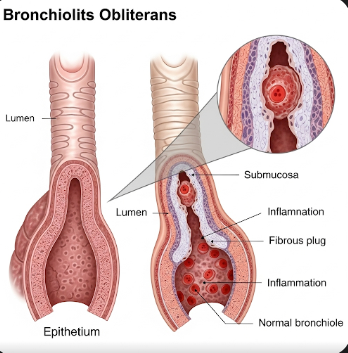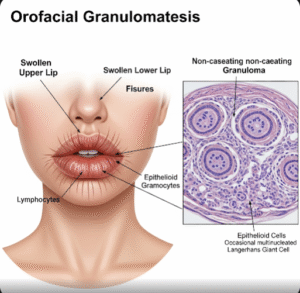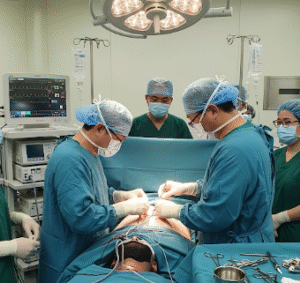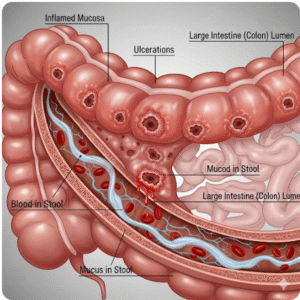Overview
Bronchiolitis Obliterans (BO) is a rare but serious chronic lung disease characterized by progressive inflammation and scarring of the small airways (bronchioles), leading to airflow obstruction and respiratory difficulties. This condition can result in long-term lung damage and significantly impact a patient’s quality of life if not recognized and managed early.
In Korea, BO is treated in pulmonology and respiratory specialty clinics, where patients receive accurate diagnosis using advanced imaging, specialized lung function tests, and multidisciplinary care. Korean healthcare emphasizes early detection, symptom control, and interventions to prevent disease progression.
What is Bronchiolitis Obliterans?
Bronchiolitis Obliterans is a progressive obstructive lung disease that occurs when the bronchioles become inflamed, scarred, and partially or completely blocked. Unlike typical bronchiolitis, which is often acute and self-limiting, BO is irreversible and can lead to chronic respiratory insufficiency.
Key characteristics include:
- Fibrosis and narrowing of the small airways
- Chronic inflammation of bronchioles
- Persistent cough and wheezing
- Progressive airflow limitation
Bronchiolitis Obliterans can be classified based on cause:
- Post-infectious BO: Following severe viral or bacterial infections
- Toxic inhalation BO: Due to inhalation of chemicals, smoke, or toxic fumes
- Transplant-related BO: Common in patients after lung or bone marrow transplants, known as bronchiolitis obliterans syndrome (BOS)
- Idiopathic BO: Cases with no identifiable cause
Symptoms
Symptoms often develop gradually and can be subtle in early stages, including:
- Persistent dry cough
- Shortness of breath, especially during exertion
- Wheezing and chest tightness
- Fatigue and reduced exercise tolerance
- Recurring respiratory infections
- Cyanosis (bluish lips or fingertips) in severe cases
- Weight loss or failure to thrive in children
Symptoms usually progress slowly, making early detection challenging, but timely intervention can improve prognosis and quality of life.
Causes
Bronchiolitis Obliterans arises from injury to the small airways, leading to scarring and obstruction:
- Severe respiratory infections, including adenovirus, influenza, or measles
- Inhalation of toxic substances, such as nitrogen dioxide, ammonia, or chemical fumes
- Post-transplant complications, particularly chronic graft-versus-host disease (GVHD) in bone marrow transplant recipients
- Drug reactions, including certain chemotherapy agents or antibiotics
- Autoimmune disorders leading to chronic airway inflammation
The injury triggers a fibrotic response, permanently narrowing the bronchioles and restricting airflow.
Risk Factors
- History of severe viral or bacterial lung infections
- Exposure to environmental or occupational toxins
- Undergoing lung or bone marrow transplantation
- Autoimmune or inflammatory diseases
- Children with severe infections or premature infants
- Smoking or chronic exposure to pollutants
Complications
If left untreated, Bronchiolitis Obliterans can lead to:
- Progressive respiratory failure
- Chronic hypoxemia (low blood oxygen)
- Pulmonary hypertension and right-sided heart strain
- Recurrent lung infections
- Severe fatigue and reduced quality of life
- Requirement for long-term oxygen therapy or lung transplantation
Prevention
Preventive strategies focus on avoiding airway injury and managing risk factors:
- Early treatment of severe respiratory infections
- Avoiding exposure to toxic chemicals or fumes
- Vaccinations against influenza, RSV, and other respiratory pathogens
- Protective measures during occupational exposure
- Careful monitoring post-transplant to detect early signs of airway obstruction
- Smoking cessation and maintaining clean indoor air
Treatment Options in Korea
Diagnosis
Accurate diagnosis is critical for managing progression:
- Medical history and physical examination
- Pulmonary function tests (PFTs) to assess airflow limitation
- High-resolution CT (HRCT) scans to visualize airway narrowing and scarring
- Bronchoscopy for direct examination and possible biopsy
- Sputum culture and blood tests to rule out infections or autoimmune causes
Medical Management
Treatment is primarily supportive and aimed at slowing disease progression:
- Bronchodilators to relieve airway constriction
- Corticosteroids to reduce inflammation, especially in early stages
- Immunosuppressive drugs in post-transplant or autoimmune-related cases
- Antibiotics to manage recurrent infections
- Oxygen therapy for patients with low blood oxygen
- Pulmonary rehabilitation to improve lung function and exercise tolerance
Surgical and Advanced Interventions
- Lung transplantation may be considered in end-stage BO
- Minimally invasive procedures for localized airway obstruction
- Korean hospitals offer specialized post-transplant care and advanced surgical options for patients with severe disease
Supportive Care
- Regular monitoring to detect progression early
- Breathing exercises and pulmonary physiotherapy
- Patient education for recognizing early symptoms and avoiding triggers
- Nutritional support to maintain overall health and energy
Prognosis
The prognosis of Bronchiolitis Obliterans varies depending on:
- Underlying cause (post-infectious, toxic, or transplant-related)
- Severity of airway obstruction at diagnosis
- Response to treatment and adherence to therapy
- Overall health and presence of comorbidities
With early diagnosis and comprehensive care in Korea, patients can:
- Slow disease progression
- Reduce frequency of respiratory infections
- Improve quality of life through rehabilitation and supportive therapies
- Access advanced interventions including transplant if necessary
Korean healthcare provides specialized pulmonology services, advanced imaging, and multidisciplinary support, ensuring that patients with Bronchiolitis Obliterans receive effective management, symptom control, and long-term monitoring to optimize respiratory health.













